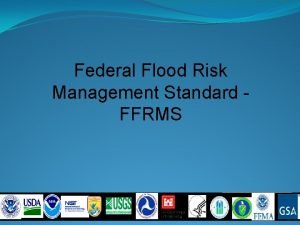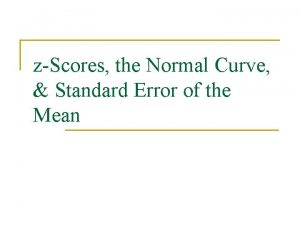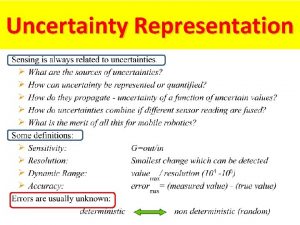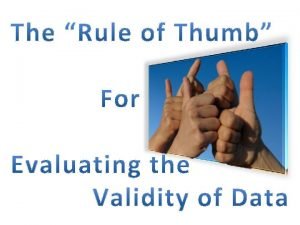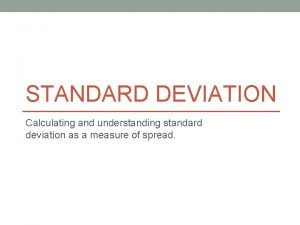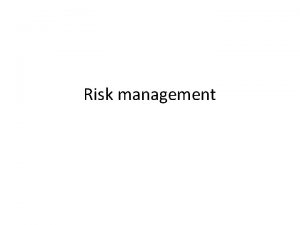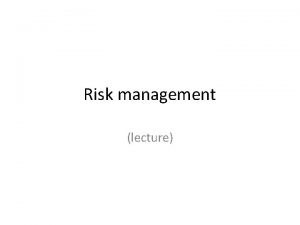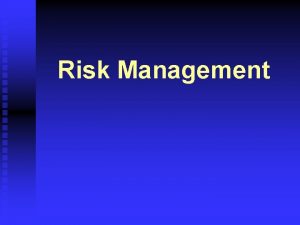Risk management Definitions of risk General standard deviation























- Slides: 23

Risk management

Definitions of risk • General: standard deviation • Finance: volatility of return(s) and costs • Risk in project management (Lockyer – Gordon): An uncertain event or set of circumstances that, should it occur, will have an effect on the achievement of the project objectives (prevent it proceeding according to the plan). The effect may be detrimental or present an unforeseen opportunity.

Uncertainty vs. risk • Uncertainty: when neither the possible events nor their possibilities are known. • Risk: when both the possible events and their possibilities are known • Uncertainty is worse than risk • Reducing uncertainty reduces risk

Importance of risk management In relatively a stable and simple environment: • Risks tend to be small • Risk management is a part of task management In changing environment: • Significant uncertainty and thus risk • If there is uniqueness in the work, manageing risk is harder • Risk management is not an option but an essential part of management

Sources of risk • • Timing Technology People Finance Managerial Political etc.

Risk from timing • All project activities are concerned • Two categories of activities for risk minimisation: – Internally timed activities: • the task owner is responsible for carrying out the activity • duration estimation is done by the project team • sources of information are – past experience of similar work – knowledge/hunches of the project team: good communication is needed – external sources, secondary information – Externally timed activities

Externally timed activities • Where some outside body sets the duration • The responsibility is of the procurement executive • After the order is placed, the delivery dates should be secured: – Systematic monitoring – Delivery performance must be recorded in the project log

Risk from technology • The newer the technology, the greater the uncertainty and thus the risk • New application of a tested technology increase the risk, too

Risk from people • Depends on people’s skill, experience and motivation • This type of risk an be reduced by: – Good communications – Clear definition of tasks – Good training: preparing the team

Risk from finance • Financial stability at every party involved • Stability of suppliers should be investigated by the procurement executive

Managerial risk • Delegation: Does the project manager and other team members have the authority to effectively deal with every problem? (especially with cross-functional problems) • Intervening after delegation can be unnecessary and a source of conflict

Political risk • Organisational politics of the parent organisation • International and national politics – Sometimes the distance increases the uncertainty

Steps of risk management • • Risk identification Creating a risk register Assess and evaluate risks (and secondary risks) Response to risk – Risk mitigation • Risk management plan

Risk identification • For the whole project lifetime • Try to identify as many areas of uncertainty as possible (build up a risk register) • Develop uncertainty into risks (probability, impact) • A network plan can help the identification • Rank the risks in order of seriousness

Risk assessment Two separate components: • Quantitatively assessment: – Statistical analysis (using past data to reveal the underlying model) • Subjective (human risk) assessment – Harder to assess and quantify Two perception: • Project manager • Project sponsor Uncertainty can give rise to benefits as well as adverse effects.

Fundamental questions of risk identification and analysis • What could go wrong? Techniques: – Brainstorming – Experience of past projects – Project networks (sources of risks & float time for mitigation) • How likely it is (possibility)? • How will it affect the project (impact)?

Risk register • List of identified risks • Explanation of the nature of each risk & the extent of damage or opportunity • Assessment: – Quantifying by assessing the probability – Sorting by the size of the problem: high, medium, low • Management methods or plans for each risk • Be aware of secondary risks: efforts to manage the primary problem can lead to a new one

Response to risk • A part of the risk management plan • Must deal with every identified risks • • Modify the project objectives Use alternative technologies or methods Use alternative project management Increase managerial strength Reduce interdependency Increase resources Increasing flexibility

Risk mitigation techniques • Risk transfer: to someone more capable (insurance is the simplest) • Risk deferral: moving risk in time • Risk reduction: – Probability – Impact • Risk acceptance: reserve or contingency plan • Risk avoidance: replace the risky activity




Reading • Textbook chapter 7
 Average deviation
Average deviation Standard error for mean
Standard error for mean Dynamic discounting definition
Dynamic discounting definition Standard definitions for techniques of supply chain finance
Standard definitions for techniques of supply chain finance Credit risk market risk operational risk
Credit risk market risk operational risk Flood risk management standard
Flood risk management standard How to find percentile rank
How to find percentile rank Standard deviation formula in grouped data
Standard deviation formula in grouped data Standard deviation symbols
Standard deviation symbols Variance formula in standard deviation
Variance formula in standard deviation Ran# in calculator
Ran# in calculator Biology standard deviation formula
Biology standard deviation formula Standard deviation desmos
Standard deviation desmos Uncertainty propagation
Uncertainty propagation Xi meaning
Xi meaning Mean difference formula
Mean difference formula Standard deviation 66 95 99
Standard deviation 66 95 99 96 confidence interval z score
96 confidence interval z score Std dev symbol
Std dev symbol Standard deviation
Standard deviation Standard deviation formula
Standard deviation formula Standard deviation in continuous series
Standard deviation in continuous series Deviation in chemistry
Deviation in chemistry Biology standard deviation formula
Biology standard deviation formula





